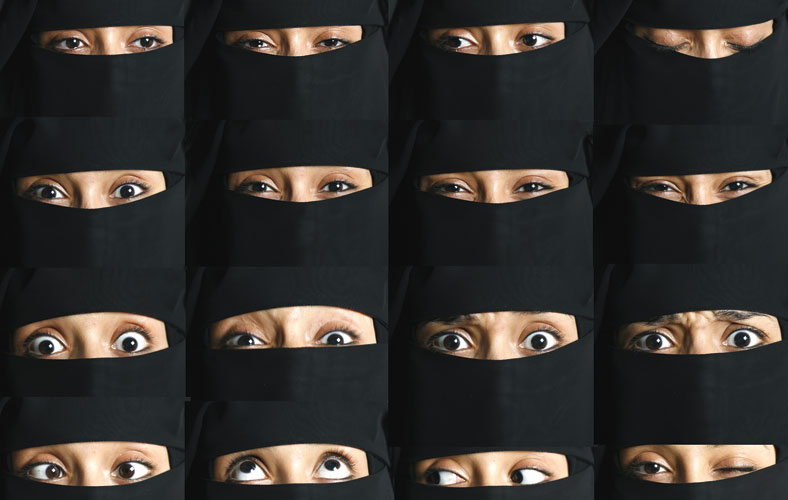
Her epiphany came on a summer day. She was sitting on the quad, her hair veiled by the hijab, the iconic head scarf, which she wore all through her first year at AU. In Yemen, where she comes from, this is what you do if you are female and Muslim and out in public.
She sat there on the quad, this veiled young woman from
Yemen, watching a group of bareheaded young Arab men hanging out nearby in
shorts and T-shirts, skin and limbs exposed, oblivious to the irony of the
situation. That's when it hit her.
"Why am I all covered up?" she asked herself. "Am I covered up so that they don't look at me?" What about them? The Koran teaches modesty for all Muslims, male and female: thou shalt not draw attention to thyself. But there they were—and here she was. Why?
Her epiphany led to a question—and a fantasy: What if roles were reversed and men, not women, were the ones who had to cover? It was a fantasy that Boushra Almutawakel, Kogod/BSBA '94, would explore as an artist.
Born in Yemen, educated in the United States, now living in Paris, Almutawakel, now 42 years old and considered a pioneer among Yemeni female photographers, knows how to negotiate the chasms and contradictions of culture, religion, and politics. When it comes to the hijab, you might call her ambivalent or a chameleon or even a little bit schizo. She wears it—or not—depending on context and personal comfort. "Many women wear the veil for religious, traditional, historical, or personal reasons, sometimes even a combination. It wouldn't be normal, say, here in the West, to walk out in the street naked," she says. "I feel naked when I'm not covered back home when I'm out in public. I also feel protected somehow."
Almutawakel had planned to study architecture, but her father disapproved of the profession for a woman from a prominent, conservative family, so she majored in international business at AU. On the side she explored photography, taking a summer course at the School of Communication, working in the photo lab, shooting events for the Eagle, and covering DC's homeless for the yearbook. She fell in love with the medium, but it was an aesthetic attraction. She wasn't equipped, not yet, to take on her fantasy, to say something with her images.
When a friend suggested that she turn her camera on her culture or her religion, she got serious about making pictures and enrolled in photography school in Atlanta, Georgia. She mastered technique, and she experimented with subject matter, zooming in on the hijab. And she revisited her fantasy to create her serial piece What If? But still, she says, "I didn't know the powerful impact photography can have—how one photo can speak volumes."
And then September 11 happened. "It was really upsetting to watch this horrendous act, but I felt like it completely marred Islam in a dramatic way." Suddenly all Muslims were being judged, and Islam equaled terrorism. "I knew in my heart that it wasn't like that," she says. "Westerners were speaking for us," but "it was our responsibility as Muslims to counter the negative in our words and actions." She wanted to voice her point of view, as a woman, as an artist, to challenge stereotypes and prejudices, both Western and Arab, and to explore the layers of identity beyond the veil. Suddenly, in the chaos of that terrible time, Boushra Almutawakel knew what she wanted to say.
She didn't intend to focus on the hijab as a photographic subject. At first she tried to avoid it, wary of reinforcing the orientalist stereotype, the cliché, of the Arab woman as exotic, romantic, mysterious. Wary, too, of encouraging the Western tendency to see only the veil but not the woman wearing it—and then to equate it with oppression. The hijab, she says, is a potent symbol that stirs up strong emotions.
But Almutawakel kept coming back to it—this piece of fabric, this article of clothing, so benign and common that its presence barely registers if you come from Yemen; so visible, and not so benign, if you come from the West. She photographed the hijab to look beyond it.
The hijab itself is not the issue, she says. "The issue for me is how women are treated. It's about intolerance, it's about extremism, it's about women's rights—or lack thereof."